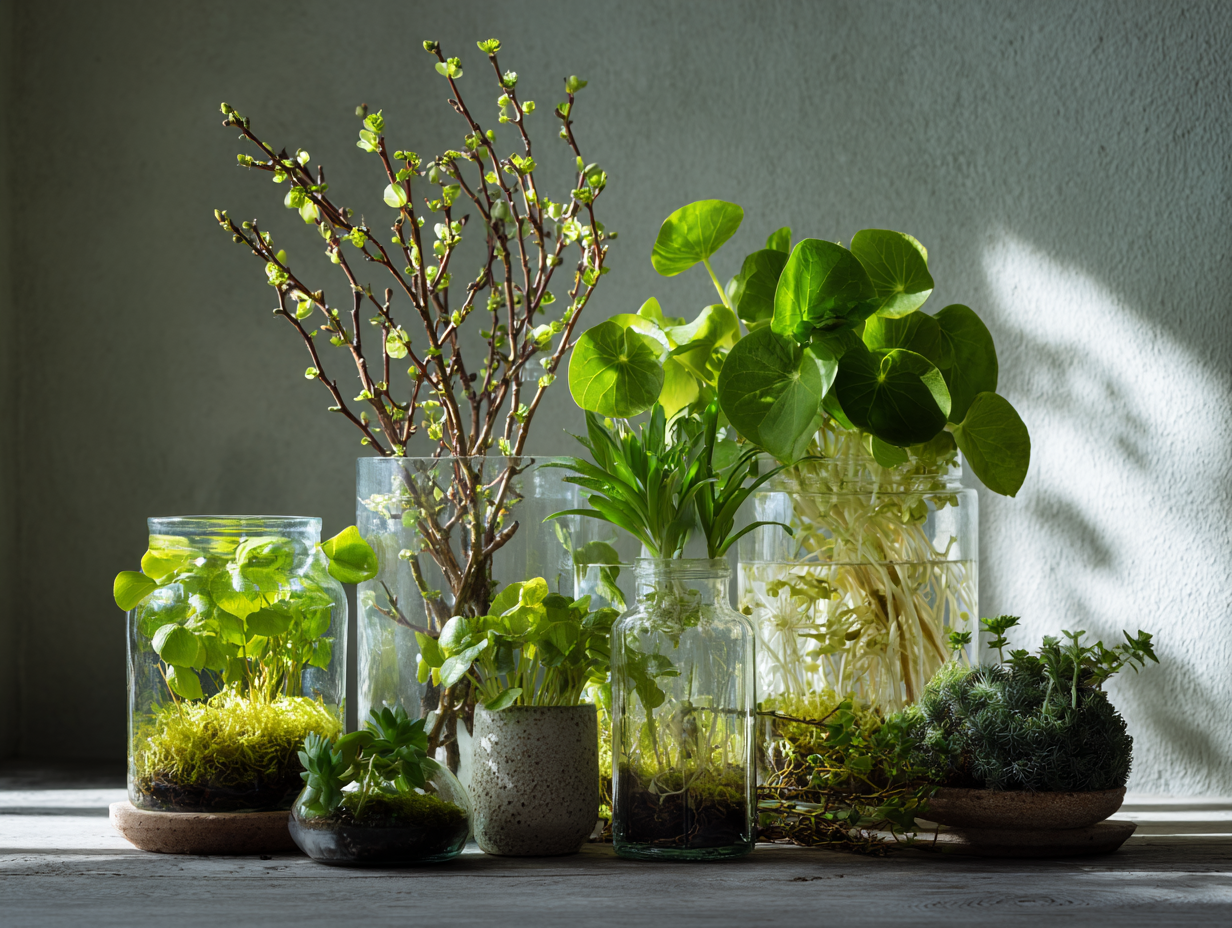Free Year-Round Propagation Calendar
Get our detailed month-by-month calendar showing exactly when to propagate each plant type for maximum success rates.
Download Free CalendarTiming is everything in plant propagation. Understanding seasonal rhythms can dramatically improve your success rates and help you build a thriving collection year-round. Here's your guide to working with nature's calendar.
Understanding Plant Seasonal Cycles
Plants follow natural rhythms that affect their ability to root, grow, and thrive. Even indoor plants respond to seasonal changes in light, temperature, and humidity. By aligning your propagation efforts with these natural cycles, you can achieve much higher success rates.
🌱 How Seasons Affect Plant Propagation:
- • Spring: High energy, rapid root development, optimal hormone levels
- • Summer: Fast growth but heat stress risk, need for extra humidity
- • Fall: Slowing growth, plants preparing for dormancy, mixed results
- • Winter: Dormant period, minimal growth, challenging conditions
Spring: The Propagation Powerhouse (March - May)
Spring is the golden season for plant propagation. Plants are emerging from winter dormancy with renewed energy and optimal hormone levels for root development.
🌸 Spring Propagation Champions
Optimal Plants:
- • Pothos (all varieties)
- • Philodendrons
- • Monstera species
- • Rubber trees (Ficus)
- • Tradescantia
- • Spider plants
- • Most tropical houseplants
Why Spring Works:
- • Increasing daylight hours
- • Naturally warming temperatures
- • High auxin (rooting hormone) levels
- • Active growth phase beginning
- • Optimal humidity conditions
Spring Propagation Tips:
- • Take cuttings in early morning when plants are fully hydrated
- • Use rooting hormone for faster results (though often unnecessary)
- • Expect roots within 1-3 weeks for most species
- • Perfect time for division of established plants
- • Start your trading stock for the year
Summer: Strategic Propagation (June - August)
Summer can be excellent for propagation, but requires more attention to prevent heat stress and maintain proper humidity levels.
☀️ Summer Success Strategies
Best Summer Plants:
- • Succulents (jade, echeveria)
- • Heat-loving tropicals
- • Begonias
- • Coleus
- • Geraniums
- • String of hearts/pearls
Summer Challenges:
- • Heat stress on cuttings
- • Rapid water evaporation
- • Intense sun can scorch
- • Higher risk of bacterial rot
- • Vacation care complications

Summer Modification Tips:
- • Move propagation station away from direct sun
- • Check water levels daily in hot weather
- • Use humidity domes or plastic bags for extra moisture
- • Consider air conditioning effects on humidity
- • Perfect time for outdoor propagation setups
Fall: The Transition Season (September - November)
Fall can be tricky for propagation as plants begin preparing for winter dormancy, but it's an excellent time for certain species and preparation for winter care.
🍂 Fall Propagation Focus
Good Fall Candidates:
- • Hardwood cuttings (woody plants)
- • Bulb offsets and division
- • Leaf propagation (succulents)
- • Root division projects
- • Herb cuttings for indoor winter growing
Fall Considerations:
- • Decreasing daylight hours
- • Dropping temperatures
- • Lower humidity indoors
- • Plants entering dormancy
- • Heating season beginning
Fall Preparation Strategy:
- • Take cuttings early in fall before dormancy
- • Set up grow lights for winter propagation
- • Increase humidity around propagation areas
- • Focus on hardy, fast-rooting species
- • Prepare winter care adjustments
Winter: Patience and Planning (December - February)
Winter is the most challenging season for propagation, but not impossible. Success requires understanding which plants can handle the conditions and adjusting your methods accordingly.
❄️ Winter Propagation Reality
Still Possible:
- • Pothos (very hardy)
- • ZZ plant leaf cuttings
- • Snake plant divisions
- • Succulent leaf propagation
- • African violet leaves
- • Holiday cactus segments
Winter Obstacles:
- • Minimal natural light
- • Dry indoor air from heating
- • Slow growth rates
- • Risk of rot from overwatering
- • Plant dormancy period
Winter Success Modifications:
- • Use grow lights to supplement natural light
- • Add humidifiers near propagation areas
- • Reduce watering frequency but monitor closely
- • Use bottom heat mats for faster rooting
- • Be patient - everything takes longer
Monthly Propagation Calendar
Here's your month-by-month guide to optimal propagation timing:
January - March: Planning & Early Prep
- • Plan year's propagation goals
- • Set up grow lights
- • Winter-hardy succulents only
- • Prepare propagation stations
- • Start hardiest tropical cuttings
- • African violet leaf propagation
- • Spring propagation begins!
- • Pothos, philodendrons, tradescantia
- • Division of established plants
April - June: Peak Propagation Season
- • All tropical houseplants
- • Monstera and rubber trees
- • Perfect success rates
- • Continue spring momentum
- • Start outdoor herb propagation
- • Begin summer prep
- • Transition to summer care
- • Heat-loving plants excel
- • Increase humidity measures
July - September: Summer Heat & Fall Prep
- • Succulents thrive
- • Shade tropical propagation
- • Daily water monitoring
- • Peak summer challenges
- • Focus on heat-tolerant species
- • Prepare fall strategy
- • Early fall propagation window
- • Hardwood cutting season begins
- • Prepare for shorter days
October - December: Winding Down & Winter Prep
- • Last chance for tropicals
- • Focus on divisions
- • Set up winter growing conditions
- • Hardy species only
- • Increase artificial lighting
- • Humidity adjustments
- • Minimal propagation activity
- • Planning next year
- • Maintain existing propagations
Adjusting Care by Season
Beyond propagation timing, your existing plants need seasonal care adjustments to stay healthy and ready for future propagation:
🌱 Spring & Summer Care
- • Watering: Increase frequency as growth accelerates
- • Fertilizing: Resume regular feeding schedule
- • Repotting: Best time for root-bound plants
- • Pruning: Shape plants to encourage new growth
- • Monitoring: Watch for rapid growth spurts
❄️ Fall & Winter Care
- • Watering: Reduce frequency, check soil first
- • Fertilizing: Stop or reduce to minimal levels
- • Humidity: Add humidifiers or pebble trays
- • Lighting: Supplement with grow lights
- • Temperature: Avoid cold drafts and heat sources
Building Your Year-Round Strategy
The most successful plant parents think seasonally and plan ahead. Here's how to build your year-round propagation and care strategy:
Winter Planning Phase
Use the slow season to research new plants, plan spring propagation goals, and upgrade your setup.
Spring Action Phase
Execute your propagation plan aggressively - this is your highest-success window.
Summer Maintenance Phase
Focus on keeping plants healthy and continuing selective propagation with heat precautions.
Fall Transition Phase
Prepare plants for winter, complete final propagation projects, adjust care routines.
Climate and Location Considerations
Your local climate significantly affects these seasonal recommendations. Here's how to adjust:
🌍 Regional Adaptations:
Tropical/Warm Climates:
- • Extended growing seasons
- • Year-round propagation possible
- • Focus on humidity management
- • Adjust for extreme heat periods
Cold/Northern Climates:
- • Shorter outdoor growing season
- • Extended heating season effects
- • Greater need for supplemental lighting
- • Plan for longer winter dormancy
Working with the seasons rather than against them is one of the most important skills in plant parenting. By understanding and embracing these natural rhythms, you'll not only achieve better propagation success but also develop a deeper connection with your plants and their needs.
Remember: every climate is different, and every plant is an individual. Use this guide as a starting point, but always observe your plants and adjust based on their responses to your local conditions.
Get Seasonal Plant Care Reminders
Join our community to receive timely reminders about seasonal plant care, propagation windows, and trading opportunities that match your local growing conditions.
Join Our Growing Community